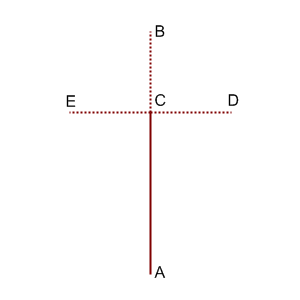topcoder SRM500 DIV1 level2 500分
来源:互联网 发布:jx300xp 软件培训课件 编辑:程序博客网 时间:2024/05/18 04:52
Problem Statement
Nick likes to draw fractals. For the special occasion of Single Round Match 500, he decided to draw the 500th generation of his favorite fractal.Each generation of the fractal can be described as a set of segments on the plane. Some of these segments are calledfinal and all other are considered to benon-final. In each non-final segment, one of its endpoints is chosen and called theroot of this segment. In pictures below, solid and dotted lines are used to represent final and non-final segments, correspondingly.
The first generation consists of one segment with endpoints (0, 0) and (0, 81). This segment is non-final and its root is (0, 0).

The i-th generation, i >= 2, is produced from the (i-1)-th generation as follows. All final segments from the (i-1)-th generation are included into the i-th generation without any changes. For each non-final segment from the (i-1)-th generation, let A and B be its endpoints, with A being its root. The following steps are then done:
- The point C is drawn on the segment AB so that the length of segment AC is twice as large as the length of segment BC.
- Segment CD is drawn as the rotation of segment CB around point C by 90 degrees clockwise.
- Segment CE is drawn as the rotation of segment CB around point C by 90 degress counter-clockwise.
- Segment AC is included in the i-th generation as a final segment.
- Segments CB, CD and CE are included in the i-th generation as non-final segments. The root of each of these three segments is point C.


Consider a rectangle R on the plane that consists of points (x, y), such that x1 <= x <= x2 and y1 <= y <= y2. Let S be the set of all segments of the 500-th generation of the fractal described above (both final and non-final ones). Return the total length of all parts of segments from S that belong to rectangle R.
Definition
Class:FractalPictureMethod:getLengthParameters:int, int, int, intReturns:doubleMethod signature:double getLength(int x1, int y1, int x2, int y2)(be sure your method is public)Notes
-The returned value must have an absolute or relative error less than 1e-9.Constraints
-x1 will be between -100 and 100, inclusive.-x2 will be between x1+1 and 100, inclusive.-y1 will be between -100 and 100, inclusive.-y2 will be between y1+1 and 100, inclusive.Examples
0)-1
0
1
53
Returns: 53.0Only one part of fractal segments belongs to this rectangle: (0, 0) - (0, 53).1)
1
1
10
10
Returns: 0.0No parts of fractal segments belong to this rectangle.2)
-10
54
10
55
Returns: 21.0Two parts of fractal segments belong to this rectangle: (-10, 54) - (10, 54) and (0, 54) - (0, 55). Note that parts that lie on the rectangle's border also belong to the rectangle.3)
14
45
22
54
Returns: 2999.0
【题解】
我的思路和官方思路不一样。官方思路基于的是矩形切割,分治(貌似)
我的思路是将每个方格包含多少长度统计出来,最后输出答案。
离散化即可(包括点、线段)
【代码】
#include <vector>#include <list>#include <map>#include <set>#include <deque>#include <stack>#include <bitset>#include <algorithm>#include <functional>#include <numeric>#include <utility>#include <sstream>#include <iostream>#include <iomanip>#include <cstdio>#include <cmath>#include <cstdlib>#include <ctime>using namespace std;double s[505][505];class FractalPicture{public:double getLength(int, int, int, int);};int get(int x){ return (x+100)*2;}int get(int x,int y){ return (min(x,y)+100)*2+1;}int dir(int x1,int y1,int x2,int y2){ return x1==x2;}void work(int gg,int x1,int y1,int x2,int y2){ int i,len,x,y; if (gg>500) return; len=abs(x1-x2)+abs(y1-y2); if (len>1) { int l=len/3; x=(x1+2*x2)/3; y=(y1+2*y2)/3; if (dir(x1,y1,x2,y2)==0) { int ll=min(x1,x),rr=max(x1,x); for (i=ll;i<rr;i++) s[get(i,i+1)][get(y1)]+=1; work(gg+1,x,y,x,y-l); work(gg+1,x,y,x,y+l); } else { int ll=min(y1,y),rr=max(y1,y); for (i=ll;i<rr;i++) s[get(x1)][get(i,i+1)]+=1; work(gg+1,x,y,x-l,y); work(gg+1,x,y,x+l,y); } work(gg+1,x,y,x2,y2); } else { if (dir(x1,y1,x2,y2)==0) { s[get(x1,x2)][get(y1)]+=1; s[get(x1,x2)][get(y1)-1]+=double(500-gg)/3; s[get(x1,x2)][get(y1)+1]+=double(500-gg)/3; } else { s[get(x1)][get(y1,y2)]+=1; s[get(x1)-1][get(y1,y2)]+=double(500-gg)/3; s[get(x1)+1][get(y1,y2)]+=double(500-gg)/3; } return; }}double FractalPicture::getLength(int x1, int y1, int x2, int y2){work(1,0,0,0,81);double ans=0;int i,j;for (i=x1;i<x2;i++) for (j=y1;j<y2;j++) { ans+=s[get(i,i+1)][get(j)]; ans+=s[get(i)][get(j,j+1)]; ans+=s[get(i,i+1)][get(j,j+1)]; } for (i=x1;i<x2;i++) ans+=s[get(i,i+1)][get(y2)]; for (i=y1;i<y2;i++) ans+=s[get(x2)][get(i,i+1)]; return ans;}//以下的正式比赛是用不上。int main(){ int x1,y1,x2,y2; cin >> x1 >> y1 >> x2 >> y2; FractalPicture a; cout << a.getLength(x1,y1,x2,y2);}- topcoder SRM500 DIV1 level2 500分
- topcoder SRM500 DIV1 LEVEL1 250分题
- topcoder SRM500 div1 Level3
- topcoder SRM500 div1 Level3
- topcoder SRM495 div1 level2
- topcoder算法题SRM144 DIV1 500分题
- Topcoder SRM552 Div1 500
- TopCoder SRM687 div1 500
- topcoder srm608 div1 300分题
- TopCoder - SRM521 div1 500 RangeSquaredSubsets
- Topcoder SRM Div2 Level2
- Topcoder SRM630,DIV1,500,后缀数组
- Topcoder SRM 503 DIV1 500 KingdomXCitiesandVillages
- Topcoder.SRM527.Div1.T2
- topcoder SRM495 div1 level3
- TopCoder SRM480 DIV1 Practise
- Topcoder--SRM144 div1
- topcoder SRM598 div1
- Spring + Apache Tiles 小配一下
- 见证1
- 创建表,提示ORA-00959: 表空间 'MC_DATA' 不存在。
- Android中的几种网络请求方式详解
- Linux下设置SSH Server保持长时间连接
- topcoder SRM500 DIV1 level2 500分
- com.sun.xml.internal.bind.v2.runtime.IllegalAnnotationsException:
- Linx 卷管理详解--VG LV PV
- window服务和测试(一)
- 在灰度图像上划线
- 利用TCP协议通过Socket编写的网络聊天工具1-客户端
- 苹果CEO库克指微软Win 8融合战略难获成功
- IPB帧编码顺序(解码顺序)与显示顺序
- 《大话数据结构》--学习笔记7


